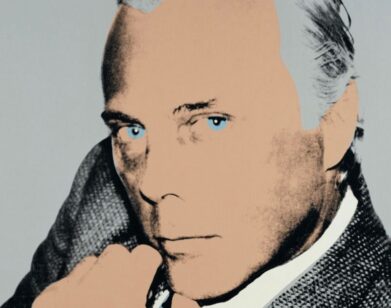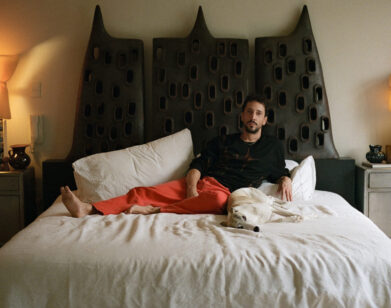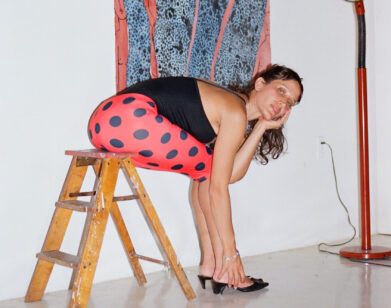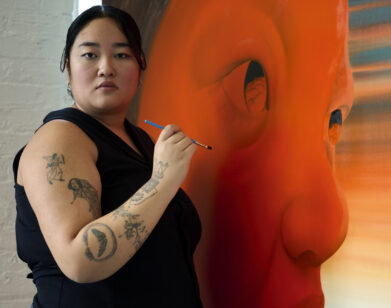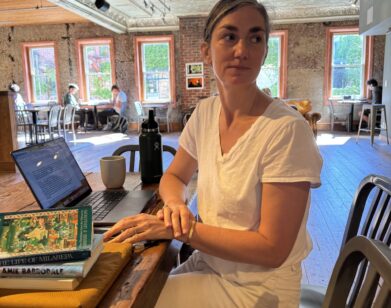Boris Charmatz’s Museum on the Move
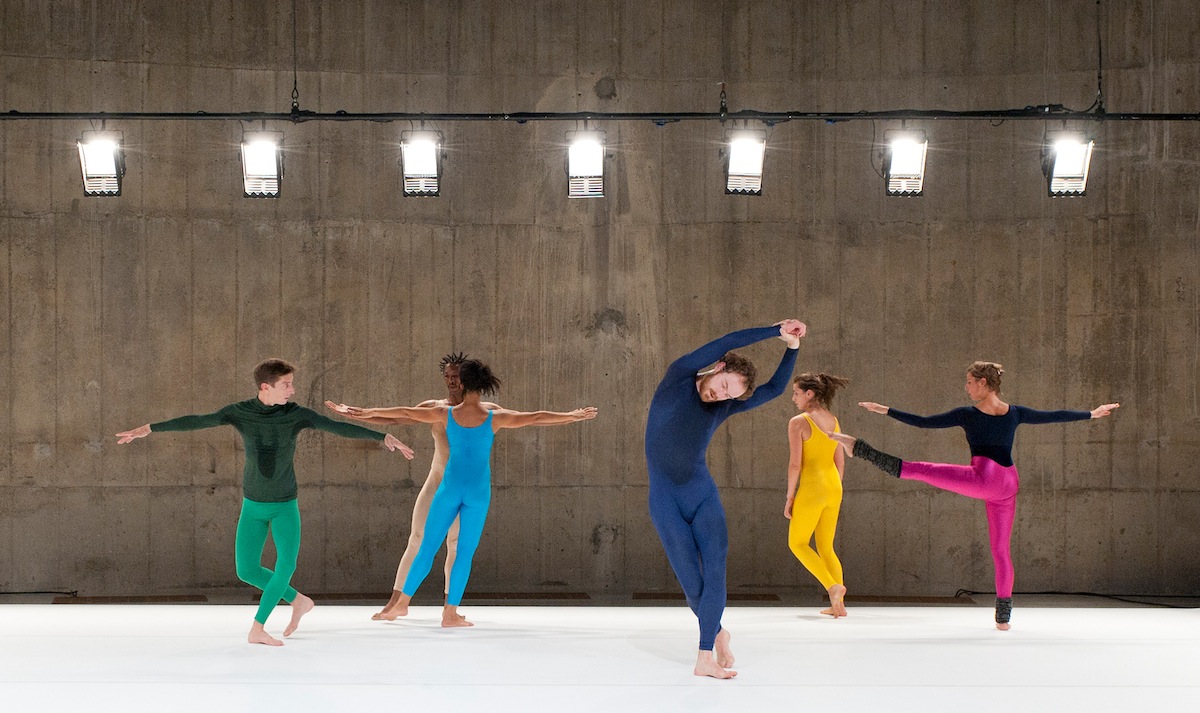
ABOVE: MUSÉE DE LA DANSE’S 2008 WORK “FLIP BOOK,” PERFORMED AT THE TATE MODERN. IMAGE COURTESY OF GABRIELLE FONSECA JOHNSON
When choreographer Boris Charmatz was first appointed as the director of the National Choreographic Center in Rennes, France, in 2009, his immediate instinct was to transform the museum into the Musée de la danse (The Dancing Museum). The purpose of such a drastic transformation—the ideas behind which he clearly documented in a “Manifesto for a Dancing Museum“—was to expose the experimental liberty and theoretical possibilities within dance. At first, it’s easy to feel overwhelmed by these abstract statements about what movement is and should be; but when you speak to Charmatz, he makes it clear that his intention is more to broaden the definition of dance in our bodies and our minds: that a dancing museum is a free and open space that is always in collaborative evolution. The main question he poses: How can we exhibit movement within the fixed idea of the visual art museum? Even Charmatz himself cannot answer concisely. He is always exploring new concepts of what the dancing museum can be and conversing on how to share movement with other dancers, viewers, and artists.
Over three weekends from October 18 through November 3, MoMA will present “Musée de la danse: Three Collective Gestures,” a performance art exhibit in collaboration with Charmatz. Each weekend, dancers will perform a new piece within the museum—each work and each dancer acting as a museum within the MoMA. Charmatz says he is pleasantly unsure how people will respond to movement in a space traditionally reserved for visual art. What he is sure of, though: a dance museum exists within dancers’ bodies, where they remember the movement and can perform it, talk about it, and exhibit it.
MOLLY ELIZALDE: What constitutes a dancing museum?
BORIS CHARMATZ: What constitutes the Musée de la danse in Rennes is very concrete. But I could also say that it’s just an idea first. And, somehow, even if we become more and more of a real institution, I hope it stays as an idea that makes you move, that makes visual artists think, “Ah, I could do this.” So I would say the first constitution is mental. We also have concrete spaces here in Rennes, but it’s still more a mental space, I would say, or, at least, it’s a double space—mental and very, very concrete.
ELIZALDE: That’s interesting because you have your manifesto, which is very much full of ideas, so I was having a hard time picturing what the actual museum was like.
CHARMATZ: I’m directing a National Choreographic Center in France—there are 19 of them, so it’s not the only one. But it’s the only one that has this idea to become the Musée de la danse. Before I arrived this was a place for artists in residency and mainly for support for the director’s work. But, of course, since I arrived, we started Musée de la danse. So the place has changed completely and it is now a public space where people visit. Before it was more a place to prepare a piece, to rehearse, to start a work.
ELIZALDE: How does the museum as a creative space lend itself to dance and the ideas that you want people to take out of the museum?
CHARMATZ: Musée de la danse was an open question, and I hope it remains. So the idea of: What is really a museum? What is really dance?, is also open. I’ve found nobody who could tell me, “Okay, a museum is this, this, this.” There’s many, many different kinds of museums in the world, and there’s not many dance museums. I started discussing with architects, with visual artists, with curators, with dancers, of course, with visitors, with anybody, and we could tell them, “Okay, we are starting a Musée de la danse. What do you think? What could we do?” And so it was a mental, open question so that different people could connect. I will always remember this architect, in one of the first exhibitions we did called Expo Zéro, he said, “If you have no object, a museum can be a climate museum. In a real museum, you have to save the objects, you have to rebalance the humidity level, the temperature for the visitors. And if there’s no object, we are completely free to rethink the spaces.” So we started like that. We did a sweating room to really transform the atmosphere. And I was thinking, if we do it in front of a picture, then the picture will start to be disturbed by the sweat of the people. So it’s just to say, “What is Musée de la danse? Where does it start? Where does it end?” So it’s not definitive.
ELIZALDE: I like that answer, because I think something that people might have a difficult time understanding in terms of looking at dance as a museum piece, is that it’s so temporal.
CHARMATZ: You always think dance is ephemeral, is immaterial. But, actually, there’s a lot of text, there’s scores, there’s a lot of videos, there’s a lot of pictures. And you can say that a dancer dancing is not an object, but you can turn it into an object. So, in fact, we think we are live art, and the museum is not live art—it’s object art. But, actually, in a museum, a lot of people are moving, a lot of things are happening. And in live art, we do work a lot with dance, with objects, with props. We didn’t want to do the traditional Musée de la danse: there is one in Cuba, there is one in Stockholm, and they were formed in the ’50s. So the museology of these museums is really different from ours, because they started with collecting props, collecting costumes, or small-scale set designs, or pictures, programs. In 2013, it’s completely different. So, Musée de la danse is something different than trying desperately to collect the costumes of a piece.
In dance, we have a very specific mind where, even if the most fantastic choreographer writes the most fantastic writing, this is not dance. So Nijinsky’s diary or Hijikata, the founder of Butoh’s texts—this is the way they express their art. So why not exhibit it? Why not consider it as art and dance? Because when I am reading the thoughts and the writings, I am in front of dance, I am in front of art. I am not in front of something that is not important compared to the real dance. I don’t know where the real dance is. So, in fact, dance is not so much a physical medium, even. It’s as much a theoretical medium, or a mental medium, or a speaking medium, or a writing medium as other mediums. We must have an enlarged idea of what dance is.
ELIZALDE: Can you talk a little bit about choreographic authorship? Do you consider that one of the objects of a museum? And, in your piece Levée des conflits (Suspension of Conflicts)—that changes from body to body. I’m interested in what choreographic authorship is in terms of a piece changing with audiences, with different dancers, and with the space that you’re in.
CHARMATZ: I think it’s very important to have authors in dance. I really also like that there’s popular dances, there’s folk dances, that dance is larger than making choreography, or authors making choreography. But, of course, I’m also a choreographer. Levée des conflits was a very strange idea. I thought that we could be a group moving while still aiming to do a shape that would be completely fixed, like a sculpture. The dancers would do a turning system going from the first movement, to the second movement, to the last movement, so that, as the viewer, you would always see all the movement. There would be no beginning and end, there would be a landscape where you see the whole choreography after two seconds. In fact, with Levée des conflits, we looked for a form, we looked for a structure—how we could pass on the movement. And we came to this idea with the canon in music and, somehow, this choreographic piece is a parallel to the musical canon, where you always see the same movements but they are performed by other bodies, other dancers. It’s not one movement after another. Inside the first movement, you find the second movement.
The idea was, as bodies we are super-permeable. I don’t know who owns which movement. Even if I am the choreographer of this piece, some movements come from a friend—a dancer who died—some come from another choreographer I worked with, some come from the dancers that are in the piece, some I designed myself. I thought for MoMA it’s interesting to have this long, durational piece taking place. And also the idea that, even if it’s an immaterial, moving piece, it aims to be a sculpture. It’s not a sculpture, but I like the idea that originally the atrium was for the Barnett Newman Broken Obelisk. Somehow, we are still aiming to do something like the Broken Obelisk, except we are dancers, we are bodies. So it’s different.
ELIZALDE: Something else I’m interested in is how the history of dance plays into the museum. You’re working with contemporary movement, but you’re still harkening back to old dancers, old movements, old art pieces. So how do you work with that?
CHARMATZ: I have to say, we didn’t start Musée de la danse in order to collect movement from the past. But, we are coming to MoMA, and MoMA is the museum for modern art, the museum for 20th century art. So, we thought, how can we interact with MoMA? This is how we started the first project, 20 Dancers for the XX Century. It’s the first parallel line with the museum—the art museum and the dance museum. In dance, we don’t have museums usually because it’s in our bodies that we store things. So, we thought, Okay, the main museum is the body of the dancer. Could they just invade MoMA? Go where they want, there’s no stage, no fixed program. You don’t know who you see, what they are doing exactly. But they are performing things from the 20th century. It’s reenactments, re-appropriation, things they did themselves as dancers. Some things are blurry, some things are clear, some things are famous, some things are unknown. And they do as they want, wherever they want. Even in the street in front of MoMA. So it’s a very wide and improvised way to make a dance in MoMA but it’s still 20th century, so it’s very connected to MoMA.
ELIZALDE: That’s a really beautiful idea—dance being a museum inside of the body as muscle memory. I wonder how people who aren’t so familiar with dance, but who might frequent MoMA, would respond to that. Are you expecting to encounter a different kind of audience at MoMA?
CHARMATZ: Yeah. The main thing is that a dancer is there, they know this one solo, they can lecture it, or talk about it, do it or not do it, stop it, start it, or do something else. And I like that there’s diversity. I still don’t know how it will function in MoMA. Very often a dancer will say, “Okay, I will perform this.” And they say the title, the year, or the name of the choreographer. But maybe they don’t say, or they talk with the audience after doing it. So it’s very open. And I don’t know how visible, how invisible we will be in MoMA, because MoMA is huge and people are coming for the Kandinsky or they are coming for this and that. I think the people in New York, in MoMA, are also open to experience. But, for sure, we will not destroy or disturb the visit of the people who just want to see the Kandinsky.
ELIZALDE: Right. I’ve been in museums where there have been dancers moving in the space, and I think it’s easy if you’re someone who isn’t comfortable with it to just bypass it or stand at a distance and watch.
CHARMATZ: I also think that it would be very clear that it’s a museum inside the museum, because if I say Chaplin, and then you have some smell of Isadora Duncan, and then you have something by Balanchine, it’s clear that it’s a museum. It’s not just movement or dancers moving. So I’m quite sure people will have the feeling that it’s not just, “Oh, dancers are moving.” But, “Ah! It seems very old. It must be from the beginning of the century.” And then they talk to the performer to know more.
ELIZALDE: It’ll be interesting to see how it plays out. It’ll be different every day.
CHARMATZ: It’s not a secure project. It’s: let’s do, let’s try, let’s see how it works.
ELIZALDE: And that’s how it has to be because it’s performance.
CHARMATZ: Yeah. The tendency in the museum is to do something very clear, framed, to be sure we are placed in the museum. And with this project, it’s not only the security of a real artwork, but something where you don’t know where they are, what they’re doing. So there’s fragility in what is performed. And it’s a risk, but it’s also a chance.
We also do this last project that comes from this book on [Merce] Cunningham by David Vaughan, the archivist of the Merce Cunningham Dance Company. It’s also another way to do Musée de la danse: we take the book and we learn all the pictures by heart and we perform it widely. Of course, in New York it has a very specific smell. To come to New York where Merce Cunningham had his studio, his company, makes me feel, “Hey, okay. I’m French, we are from Europe, and we are touching something that is so American, so New York.” Somehow, we are afraid to touch it. On the other hand, things have to be touched. So we take the risk.
ELIZALDE: Yeah. And that goes back to the choreographic authorship question. The movement is within each dancer’s body and everyone is going to interpret it in a different way. Movement coming from a choreographer is going to be foreign to anybody who’s not the choreographer; you have to interpret it.
CHARMATZ: Yeah. And I think whatever you do—if you lift your arm or turn on your head—it’s not that someone did it before, but somebody taught you something that made you be able to do it. So, you’re never completely new, even with improvisation, I would say. When you improvise, it’s not looking for the new thing. It’s also how to be very aware of the context. Dance is not just a present, past, or future; it’s a mixture of these things. The past is really part of our now and our future.
“MUSÉE DE LA DANSE: THREE COLLECTIVE GESTURES” IS ON VIEW AT MOMA ON WEEKENDS FROM OCTOBER 18 THROUGH NOVEMBER 3.

